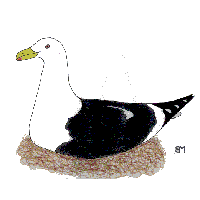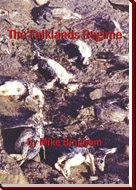 |
 |
| |
|
|
Kelp Gull Local Name: Dominican Gull Breeding Range: Falklands & southern
South America Kelp Gulls are extremely common along coasts all around the Falklands, but they mostly breed on remote coastal plains where human disturbance is minimal. Colonies of up to several hundred pairs make rudimentary nests in hollows lined with vegetation. Preferred sites are sand or shingle beaches, sand dunes, or heath and grassland behind the beach. Two or three eggs are laid in December. Chicks hatch in January, fledge in late February, and abandon the nest site along with the adults in March. Sexes are similar. Juveniles are speckled brown in colour, and do not acquire the complete adult plumage until 4 years of age. Kelp Gulls are intelligent birds, able to feed as predators or scavengers. Their diet includes eggs, chicks, marine invertebrates, carrion and refuse. In Stanley they use Ross Road to break open mussels. |
|
|
||||||||||||||||||||||||||||




